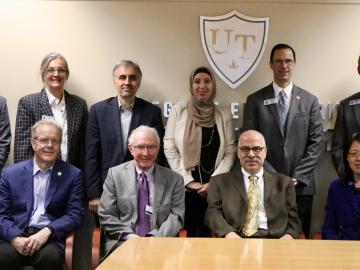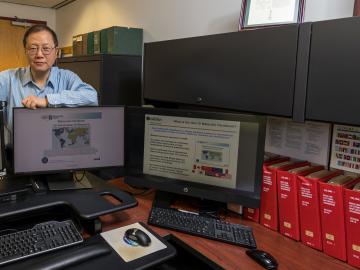
Filter News
Area of Research
- (-) Materials (64)
- (-) Nuclear Systems Modeling, Simulation and Validation (2)
- Advanced Manufacturing (10)
- Biological Systems (1)
- Biology and Environment (73)
- Building Technologies (2)
- Computational Biology (2)
- Computational Engineering (3)
- Computer Science (10)
- Electricity and Smart Grid (3)
- Energy Science (141)
- Energy Sciences (1)
- Fuel Cycle Science and Technology (1)
- Functional Materials for Energy (1)
- Fusion and Fission (31)
- Fusion Energy (13)
- Isotope Development and Production (1)
- Isotopes (9)
- Materials for Computing (12)
- Mathematics (1)
- National Security (28)
- Neutron Science (34)
- Nuclear Science and Technology (42)
- Quantum information Science (9)
- Sensors and Controls (1)
- Supercomputing (96)
News Topics
- (-) Advanced Reactors (5)
- (-) Biomedical (7)
- (-) Clean Water (3)
- (-) Composites (9)
- (-) Coronavirus (4)
- (-) Frontier (3)
- (-) Grid (5)
- (-) Machine Learning (5)
- (-) Nuclear Energy (17)
- (-) Quantum Science (11)
- 3-D Printing/Advanced Manufacturing (23)
- Artificial Intelligence (9)
- Big Data (2)
- Bioenergy (11)
- Biology (4)
- Buildings (5)
- Chemical Sciences (32)
- Computer Science (17)
- Critical Materials (13)
- Cybersecurity (4)
- Energy Storage (34)
- Environment (15)
- Exascale Computing (2)
- Fusion (7)
- High-Performance Computing (4)
- Irradiation (1)
- Isotopes (13)
- ITER (1)
- Materials (73)
- Materials Science (78)
- Mathematics (1)
- Microscopy (27)
- Molten Salt (3)
- Nanotechnology (39)
- National Security (3)
- Neutron Science (33)
- Partnerships (11)
- Physics (28)
- Polymers (17)
- Quantum Computing (3)
- Security (2)
- Simulation (1)
- Space Exploration (2)
- Summit (2)
- Transportation (14)
Media Contacts

Oak Ridge National Laboratory researchers have developed a thin film, highly conductive solid-state electrolyte made of a polymer and ceramic-based composite for lithium metal batteries.

In the race to identify solutions to the COVID-19 pandemic, researchers at the Department of Energy’s Oak Ridge National Laboratory are joining the fight by applying expertise in computational science, advanced manufacturing, data science and neutron science.

Energy storage startup SPARKZ Inc. has exclusively licensed five battery technologies from the Department of Energy’s Oak Ridge National Laboratory designed to eliminate cobalt metal in lithium-ion batteries. The advancement is aimed at accelerating the production of electric vehicles and energy storage solutions for the power grid.

Nuclear scientists at Oak Ridge National Laboratory have established a Nuclear Quality Assurance-1 program for a software product designed to simulate today’s commercial nuclear reactors – removing a significant barrier for industry adoption of the technology.

Researchers at the Department of Energy’s Oak Ridge National Laboratory have received five 2019 R&D 100 Awards, increasing the lab’s total to 221 since the award’s inception in 1963.

ORNL and The University of Toledo have entered into a memorandum of understanding for collaborative research.

Quanex Building Products has signed a non-exclusive agreement to license a method to produce insulating material from ORNL. The low-cost material can be used as an additive to increase thermal insulation performance and improve energy efficiency when applied to a variety of building products.

A modern, healthy transportation system is vital to the nation’s economic security and the American standard of living. The U.S. Department of Energy’s Oak Ridge National Laboratory (ORNL) is engaged in a broad portfolio of scientific research for improved mobility

Six new nuclear reactor technologies are set to deploy for commercial use between 2030 and 2040. Called Generation IV nuclear reactors, they will operate with improved performance at dramatically higher temperatures than today’s reactors.

Using additive manufacturing, scientists experimenting with tungsten at Oak Ridge National Laboratory hope to unlock new potential of the high-performance heat-transferring material used to protect components from the plasma inside a fusion reactor. Fusion requires hydrogen isotopes to reach millions of degrees.


